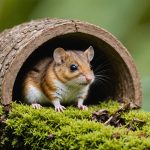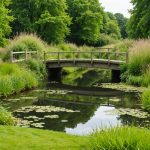Transform Your Garden into a Dormouse Sanctuary: A Guide for UK Residents to Support Endangered Species
Why Support Dormice and Other Wildlife in Your Garden?
In the UK, many wildlife species, including the hazel dormouse, are facing significant threats due to habitat loss, climate change, and other environmental factors. Creating a wildlife-friendly garden is not only a rewarding hobby but also a crucial step in supporting these endangered species. Here’s why it’s so important:
- Habitat Preservation: Dormice, like many other small mammals, rely on specific habitats to survive. Woodland areas, which are dwindling, are their natural homes. By replicating these habitats in your garden, you can provide a safe haven for these creatures.
- Biodiversity: Supporting dormice also means supporting a broader range of wildlife. Gardens that attract dormice often attract other species like birds, bats, hedgehogs, and insects, enhancing overall biodiversity.
- Climate Change Mitigation: Gardens can act as micro-habitats that help mitigate the effects of climate change. By planting native species and creating diverse habitats, you can help stabilize local ecosystems.
Understanding Hazel Dormice and Their Needs
Before you start transforming your garden, it’s essential to understand the specific needs of hazel dormice.
En parallèle : Navigating Beaver-Human Conflicts: Innovative Strategies by UK Conservationists
Habitat Requirements
Hazel dormice are arboreal, meaning they spend most of their time in trees. Here are some key habitat requirements:
- Woodland Structure: Dormice prefer areas with dense undergrowth and a mix of tree species, especially hazel, which is their namesake.
- Food Sources: They eat fruits, nuts, and insects. Planting fruit trees and maintaining a diverse garden with insect-friendly plants can be beneficial.
- Nesting Sites: Dormice need safe places to nest, such as hollow tree trunks or specially designed nest boxes.
Behavioral Insights
Understanding dormice behavior can help you tailor your garden to their needs:
A voir aussi : Designing Urban Green Spaces in the UK: A Blueprint for Supporting Amphibian Habitats
- Nocturnal: Dormice are active at night, so they need dark, undisturbed areas.
- Hibernation: They hibernate during the winter, so providing insulation and protection from harsh weather is crucial.
- Territorial: Dormice are territorial, so ensuring your garden is large enough or connected to other habitats can help them thrive.
Creating a Dormouse-Friendly Garden
Transforming your garden into a dormouse sanctuary involves several steps:
Planting the Right Trees and Shrubs
Planting native tree species and shrubs that provide food and shelter is key.
- Hazel Trees: These are a staple for dormice, providing both food and habitat.
- Fruit Trees: Apple, pear, and plum trees can provide a rich source of food.
- Native Shrubs: Shrubs like hawthorn, blackthorn, and elderberry are beneficial for both food and shelter.
Installing Nest Boxes and Shelters
Providing safe nesting sites is crucial for dormice.
- Dormouse Nest Boxes: These are specifically designed to mimic the natural nesting sites of dormice. Place them in trees about 2-3 meters off the ground.
- Bat Boxes and Bird Boxes: While primarily for bats and birds, these can also attract other beneficial insects and small mammals.
Managing Your Garden for Wildlife
Effective garden management can make a significant difference:
- Minimal Pest Control: Avoid using pesticides, as they can harm dormice and other wildlife. Instead, use natural pest control methods.
- Composting: Composting can help maintain soil health and attract beneficial insects.
- Leave Some Areas Wild: Leaving some parts of your garden untidy can provide habitat for insects and small mammals.
Practical Tips for Gardeners
Here are some practical tips to help you create a dormouse-friendly garden:
Risk Assessment
Before making any changes, conduct a risk assessment to ensure your garden is safe for both humans and wildlife.
- Check for Hazards: Ensure there are no hazards like loose branches or toxic plants that could harm dormice or other wildlife.
- Consult Experts: If you’re unsure, consult with local wildlife experts or join a wildlife trust to get guidance.
Using Trail Cameras
Trail cameras can help you monitor the wildlife in your garden and ensure that your efforts are paying off.
- Placement: Place trail cameras in areas where you expect to see dormice, such as near nest boxes or food sources.
- Data Collection: Use the data to adjust your garden management strategies and ensure you’re providing the right conditions.
Community Involvement
Joining local wildlife initiatives can amplify your impact:
- Wildlife Trusts: Organizations like The Wildlife Trusts offer resources, workshops, and community events to help you create wildlife-friendly gardens.
- Neighborhood Projects: Collaborate with your neighbors to create a larger, connected habitat for dormice and other wildlife.
Success Stories and Inspirations
Several conservation projects and individual efforts have shown significant success in supporting endangered species like the hazel dormouse.
Pine Martens in the South West
A pioneering conservation project brought back pine martens to the South West of England after a 100-year absence. This project highlights the potential for reintroduction and habitat restoration efforts.
Rare Plant Reintroduction
Chester Zoo’s efforts to reintroduce one of the world’s rarest plants, Cotoneaster cambricus, to a secret site in Wales demonstrate the importance of targeted conservation actions.
Table: Comparing Different Wildlife-Friendly Garden Features
| Feature | Benefits for Dormice | Benefits for Other Wildlife | Maintenance Requirements |
|---|---|---|---|
| Hazel Trees | Food and habitat | Food for birds and insects | Regular pruning |
| Fruit Trees | Food | Food for birds and bats | Annual pruning |
| Native Shrubs | Shelter and food | Shelter for hedgehogs and birds | Minimal pruning |
| Dormouse Nest Boxes | Safe nesting sites | – | Annual cleaning |
| Bat Boxes | – | Shelter for bats | Annual cleaning |
| Bird Boxes | – | Shelter for birds | Annual cleaning |
| Composting | Attracts beneficial insects | Attracts beneficial insects | Regular turning |
| Wild Areas | Habitat for insects | Habitat for small mammals | Minimal maintenance |
Quotes from Experts and Enthusiasts
- “Creating a wildlife-friendly garden is not just about supporting one species; it’s about building a resilient ecosystem that benefits all wildlife.” – David Allwright, The Wildlife Trusts.
- “Even small actions, like planting a few native trees or installing a nest box, can make a significant difference in supporting local biodiversity.” – A local gardener involved in the Somerset Wildlife Trust’s garden award scheme.
Transforming your garden into a dormouse sanctuary is a rewarding and impactful way to support endangered species. By understanding the specific needs of hazel dormice, creating the right habitat, and managing your garden effectively, you can make a real difference. Remember, every small action counts, and collective efforts can lead to significant positive change for nature.
Final Tips
- Make Sure to Research: Always research the specific needs of the species you want to support.
- Be Patient: Creating a wildlife-friendly garden takes time, so be patient and enjoy the journey.
- Get Involved: Join local wildlife initiatives and share your experiences with others to amplify the impact.
By following these guidelines and tips, you can turn your garden into a thriving sanctuary for hazel dormice and other wildlife, contributing to the broader conservation efforts in the UK.











